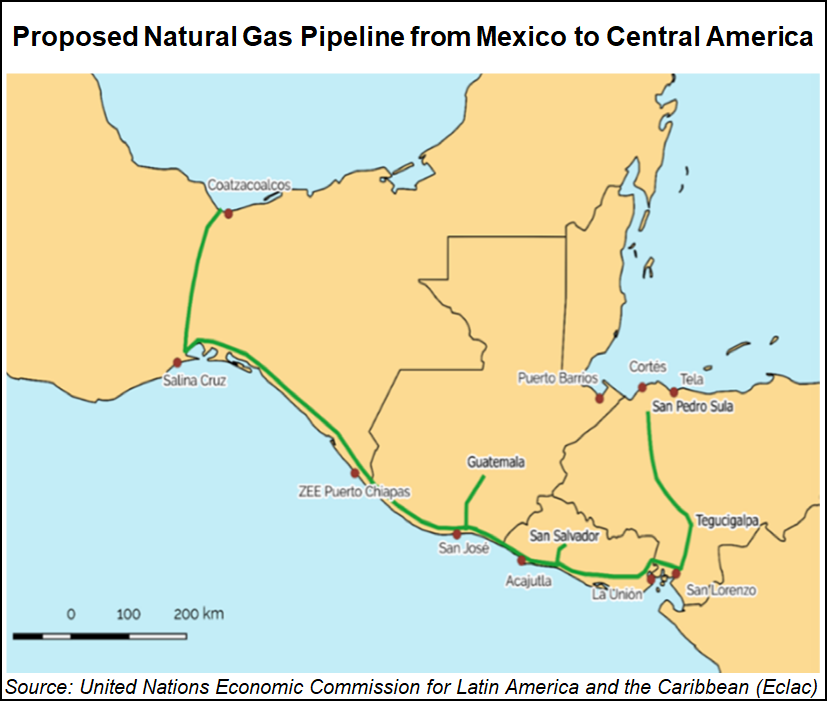Infrastructure | NGI All News Access | NGI The Weekly Gas Market Report
Marine Pipeline Begins Operations, Opens Possible Central America Opportunity
The heralded cross-border marine pipeline entered commercial operation on Tuesday following months of delays and tense contract negotiations with the Mexican utility Comisión Federal de Electricidad (CFE), opening a valve to send as much as 2.6 Bcf/d of natural gas from southern Texas to Mexico.

“After reaching an agreement with the CFE and the government of Mexico, this important energy infrastructure project provides a fundamental link between the abundant supply of low-cost natural gas and the growing Mexican markets for decades to come,” Robert Jones, President of TC Energy in Mexico, said in a joint statement by developers TC Energy and Sempra Energy’s Mexico unit Ienova. “Through this association with the CFE, we are helping Mexico reach its objective of providing energy to its growing economy with the use of economic natural gas.”
The marine pipeline will significantly increase the supply of natural gas to Mexico, particularly in the central, south and southeast regions of the country. The natural gas will be used to supply generation plants in the Caribbean ports of Altamira and Tuxpan. In future, the pipeline will supply central Mexico through interconnected pipelines under construction.
The 772-kilometer (480 miles) project required an estimated investment of $2.6 billion. The pipeline increases Mexico’s import capacity of natural gas by 40%.
“This important project will guarantee the reliable and secure supply of an economic, efficient and environmentally-friendly fuel to promote economic development, job creation and the well-being of Mexicans,” Tania Ortiz, CEO of Ienova, said. “The operation of this natural gas pipeline will promote industrial development in these regions and allow CFE to produce electric energy more economically.”
The pipeline provides an outlet to surplus natural gas production in the United States, particularly Texas, where prices have fallen to historic lows this year. It also sends much needed natural gas to Mexico and regions of the country where limited infrastructure and supply have led to higher electricity costs and power outages during times of peak demand.
Experts say the surge of natural gas imports into Mexico could be considered an opportunity to send supply to Central America. In May, Mexico unveiled a plan to assist Central America countries Guatemala, Honduras and El Salvador to bolster their economies and concluded that energy — and particularly a new natural gas pipeline — could be a driver of that development.
The plan calls for a 600-kilometer (370-mile) gas pipeline that would run south from Coatzacoalcos, also known as Pajaritos, on Mexico’s Gulf Coast, to Salina Cruz on the Pacific Coast, then south to Guatemala. From there it would head further south through El Salvador before moving north to the Honduran industrial capital, San Pedro Sula, and the port of Cortés on the Atlantic Coast.
The ambitious plan, aimed to foster economic growth in northern Central America and dissuade migration, could be more viable now that the marine pipeline is in operation, Lourdes Melgar, Mexico’s Deputy Minister of Hydrocarbons from 2014-2016, told NGI’s Mexico GPI.
“There is a project that has been up in the air since the 1990s that has died and been revived several times, which is the development of a pipeline to bring natural gas to Central America,” Melgar said. “I see that as a possibility now that the marine pipeline will be operating. With more natural gas entering the system, and if Mexico also starts to produce more natural gas, there will be a lot more natural gas available that can be used for possible export to Central America.”
Melgar believes it is important to include natural gas as part of the conversation with the United States about how to improve economic conditions and stoke development in southern Mexico and Central America. More job opportunities in the region could assist with on-going migration issues in Central American nations, she said.
“We know that there are issues related to violence and a lot of complexities in the migration issue, but certainly being able to have well-paid jobs in the region is a way to assure that people will stay in their countries and create new opportunities,” Melgar said.
Rodrigo Rosas, a gas analyst at Wood Mackenzie in Mexico City, agrees that the marine pipeline could provide more natural gas supply to Central America, although he says that a series of conditions would need to be decided prior to any project advancement.
“Considering the difficulties that have presented themselves in recent years regarding natural gas pipeline construction, I think the principal challenge would be connecting Mexico and Central America through one pipeline,” Rosas said.
He added that to do so would require the Mexican government to take a more active role during the consultation process with communities, particularly in states historically opposed to infrastructure projects, such as Chiapas.
© 2024 Natural Gas Intelligence. All rights reserved.
ISSN © 2577-9877 | ISSN © 2577-9966 | ISSN © 1532-1266 |
